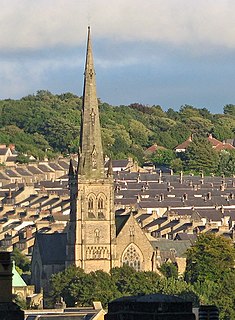
Lancaster Cathedral, also known as The Cathedral Church of St Peter and Saint Peter's Cathedral, is a Roman Catholic cathedral in Lancaster, Lancashire, England. It was a Roman Catholic parish church until 1924, when it was elevated to the status of a cathedral. It started as a mission church in 1798, and the present church was built on a different site in 1857–59. It was designed by E. G. Paley in the Gothic Revival style and is a grade II* listed building. In 1901 a baptistry was added by Austin and Paley, and the east end was reordered in 1995 by Francis Roberts. The cathedral is in active use, arranging services, concerts and other events, and is open to visitors.

St Peter's Church, Bolton-le-Moors, commonly known as Bolton Parish Church, is a Church of England parish church in Bolton, Greater Manchester, England. The parish church, dedicated to St Peter, is an example of the Gothic Revival style. The church is recorded in the National Heritage List for England as a Grade II* listed building, having been designated in 1974. St Peter's is an active parish church in the Diocese of Manchester and is part of the Bolton deanery and Bolton archdeaconry.

St Wilfrid's Church is in the village of Davenham, Cheshire, England. The church is recorded in the National Heritage List for England as a designated Grade II* listed building. It is an active Anglican parish church in the diocese of Chester, the archdeaconry of Chester and the deanery of Middlewich.

The Parish Church of St Mary the Virgin is a Church of England parish church in Leigh, Greater Manchester, England. It is a member of the Salford & Leigh deanery in the archdeaconry of Salford, diocese of Manchester. It is recorded in the National Heritage List for England as a designated Grade II* listed building.
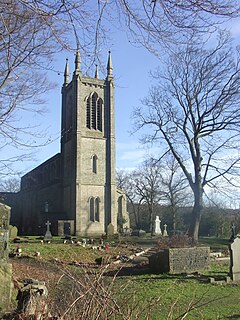
Christ Church is in Blackburn Road, Walmsley, Egerton, Greater Manchester, England. It is an active Church of England parish church in the deanery of Walmsley, the archdeaconry of Bolton, and the diocese of Manchester. The church is recorded in the National Heritage List for England as a designated Grade II listed building.

The Church of St John the Evangelist is in Waterloo Road, Cheetham Hill, Manchester, England. It is an active Anglican parish church in the deanery of North Manchester, the archdeaconry of Manchester, and the diocese of Manchester. The church is recorded in the National Heritage List for England as a designated Grade II* listed building.

St Peter's Church is in the village of Quernmore, Lancashire, England. It is an active Anglican parish church in the deanery of Lancaster and Morecambe, the archdeaconry of Lancaster, and the diocese of Blackburn. Its benefice is united with those of St Mark, Dolphinholme, and Christ Church, Over Wyresdale. The church is recorded in the National Heritage List for England as a designated Grade II listed building. It stands in a relatively isolated position about 1 mile (1.6 km) to the north of the village and 2.5 miles (4.0 km) to the east of the city of Lancaster.
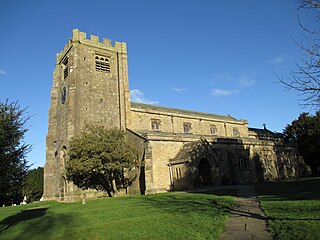
St Paul's Church is in the village of Brookhouse, Caton-with-Littledale, Lancashire, England. It is an active Anglican parish church in the deanery of Tunstall, the archdeaconry of Lancaster, and the diocese of Blackburn. The church is recorded in the National Heritage List for England as a designated Grade II* listed building.

Christ Church is in Wyresdale Road, Lancaster, Lancashire, England. It is an active Anglican parish church in the deanery of Lancaster and Morecambe, the archdeaconry of Lancaster, and the diocese of Blackburn. The church is recorded in the National Heritage List for England as a designated Grade II listed building.
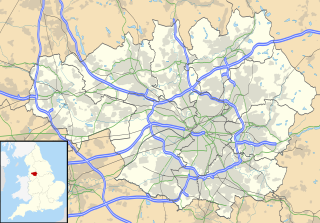
St Margaret's Church is in Burnage Lane, Burnage, a neighbourhood of Manchester, England. It is an active Anglican parish church in the deanery of Heaton, the archdeaconry of Manchester, and the diocese of Manchester. It is recorded in the National Heritage List for England as a Grade II listed building, having been designated on 9 February 2012.

Holy Trinity Church, is in the village of Bolton-le-Sands, Lancashire, England. It is an active Anglican parish church in the deanery of Tunstall, the archdeaconry of Lancaster, and the diocese of Blackburn. Its benefice is united with that of St Mark, Nether Kellett. The church is recorded in the National Heritage List for England as a designated Grade II* listed building.

St Michael and All Angels' Church is in Leigh Road, Howe Bridge, a suburb of Atherton, Greater Manchester, England. It is an active Anglican parish church in the deanery of Leigh, the archdeaconry of Salford and the diocese of Manchester. Its benefice is united with those of three local churches, St John the Baptist, St George and St Philip, forming a team ministry entitled the United Benefice of Atherton and Hindsford with Howe Bridge. The church is recorded in the National Heritage List for England as a designated Grade II* listed building.

St James' Church is in Great Cheetham Street East, Broughton, Greater Manchester, England. It is an active Anglican parish church, in the deanery of Salford, the archdeaconry of Salford, and the diocese of Manchester. Its benefice has been combined with those of St John the Evangelist, Broughton, and St Clement with St Matthias, Lower Broughton.

St Peter's Church is in Firs Lane, Westleigh, a district of Leigh, Greater Manchester, England. It is an active Anglican parish church in the deanery of Leigh, the archdeaconry of Salford, and the diocese of Manchester. The church is recorded in the National Heritage List for England as a designated Grade II* listed building. It was designed by the Lancaster architects Paley and Austin. The architectural historians Pollard and Pevsner describe it as "one of their most radical and thrilling churches".

St Mary's Church is in the town of Windermere, Cumbria, England. It is an active Anglican parish church in the deanery of Windermere, the archdeaconry of Westmorland and Furness, and the diocese of Carlisle. Its benefice is united with that of St Martin's Church, Bowness-on-Windermere; St Anne's Church, Ings; St Cuthbert's Church, Kentmere; St James' Church, Staveley and Jesus Church, Troutbeck. The church is recorded in the National Heritage List for England as a designated Grade II listed building.

St Michael and All Angels with St Marks Church is in Egerton Road, Ashton-on-Ribble, Preston, Lancashire, England. It is an active Anglican parish church in the deanery of Preston, the archdeaconry of Lancaster, and the diocese of Blackburn. Its benefice is united with those of St Mark, Preston, and St Andrew, Ashton-on-Ribble, to form the benefice of the West Preston Team. The church is recorded in the National Heritage List for England as a designated Grade II* listed building.
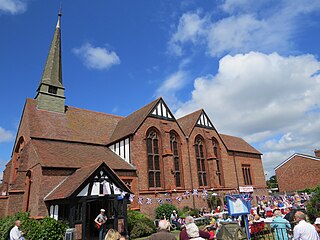
St John's Church is in St John's Road, Birkdale, Southport, Merseyside, England. It is an active Anglican parish church in the deanery of North Meols, the archdeaconry of Warrington, and the diocese of Liverpool. The church is recorded in the National Heritage List for England as a designated Grade II listed building.
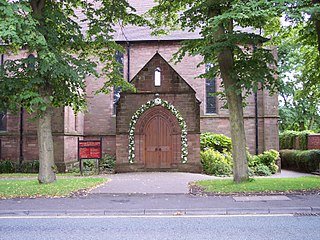
St Matthew's Church is in Billinge Road, Highfield, Pemberton, Wigan, Greater Manchester, England. It is an active Anglican parish church in the deanery of Wigan, the archdeaconry of Wigan & West Lancashire, and the diocese of Liverpool. The church is recorded in the National Heritage List for England as a designated Grade II* listed building.

St Margaret's Church is in Lonsdale Road, Halliwell, Bolton, Greater Manchester, England. It is an active Anglican parish church in the deanery of Bolton, the archdeaconry of Bolton, and the diocese of Manchester. Its benefice is united with that of Christ Church, Heaton.

St Stephen's Church is in Balcarres Avenue, Whelley, Wigan, Greater Manchester, England. It is an active Anglican parish church in the deanery of Wigan, the archdeaconry of Wigan and West Lancashire, and the diocese of Liverpool. Its benefice is united with that of St John, New Springs. The church is recorded in the National Heritage List for England as a designated Grade II listed building.





















